Expert’s Rating
Pros
- Exhilarating FPV experience
- DJI Motion controller is intuitive for newbies
- Impressive video transmission range
- Compact, durable form factor
Cons
- Expensive if you don’t have existing accessories
- Not all functions are available with Motion Controller
- No automated photo/video modes like standard DJI drones
Our Verdict
The DJI Avata is a consumer-friendly way to get into the world of fast-paced FPV piloting, with everything you need in a nice neat package. The Motion Controller is particularly handy for newbies with intuitive controls, but pro-level users may find it restrictive. The downside is the upfront cost, especially if you don’t have existing DJI FPV accessories.
DJI started its FPV (First Person View) journey in 2021 with the DJI FPV and DJI Goggles V2, but with exposed blades, a large build and sub-1080p transmission, there were improvements to be made. DJI went back to the drawing board and came up with the DJI Avata, a much more compact FPV drone ideal for those into fast-paced aerial flight.
The question is, is the DJI Avata well-suited for an FPV newbie, or is it better left to the pros? Well…
Design & build
- Compact, durable build suited to FPV flight
- Awkward USB-C/microSD card slot placement
- DJI Goggles 2 are more lightweight and comfortable
Though it’s DJI’s second-gen FPV-focused drone, the DJI Avata looks almost entirely different to the original DJI FPV. Gone are the folding arms, exposed blades and large body, replaced with something that DJI believes is lighter, more robust and better tailored to FPV flight.
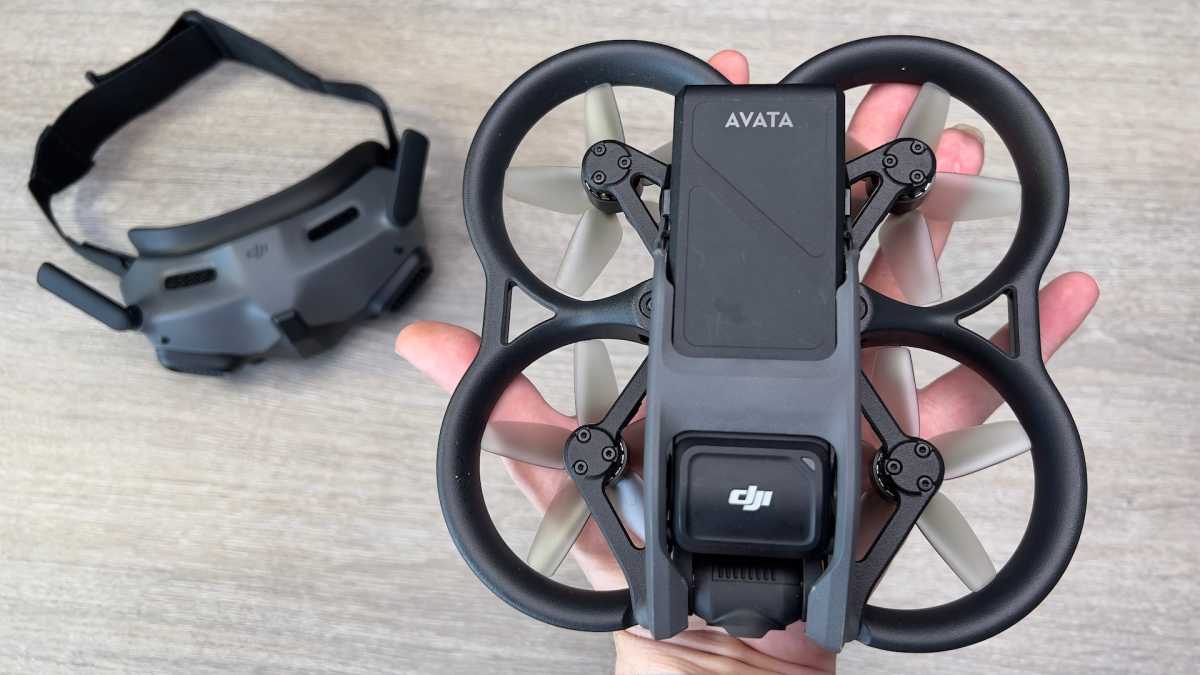
Lewis Painter / Foundry
The most obvious difference is the overall size and shape of the drone, with the DJI Avata measuring in at a compact 180 x 180 x 80mm which makes it easier to navigate small spaces compared to its 255 x 312 x 127mm predecessor. It’s almost half the weight too, coming in at a svelte 410g that allows it to zip through the air – though not quite as fast, but more on that later.
Another big change is the introduction of guards that protect the four blades of the drone. They look fairly solid in build, and although I didn’t directly collide with objects at high speed during testing, it allowed me to bump off walls lightly while keeping the drone in flight. If you do have a collision that damages the blade guards, DJI has replacements available via its website.
The battery slots into a cage on the rear of the drone, connected to the drone by a single flexible cable. It’s easy to swap out to extend flight time, but it also means the battery is more likely to survive a tumble without damaging the connectors. There’s also a small button with a line of LEDs on the battery to give you at-a-glance charge information.
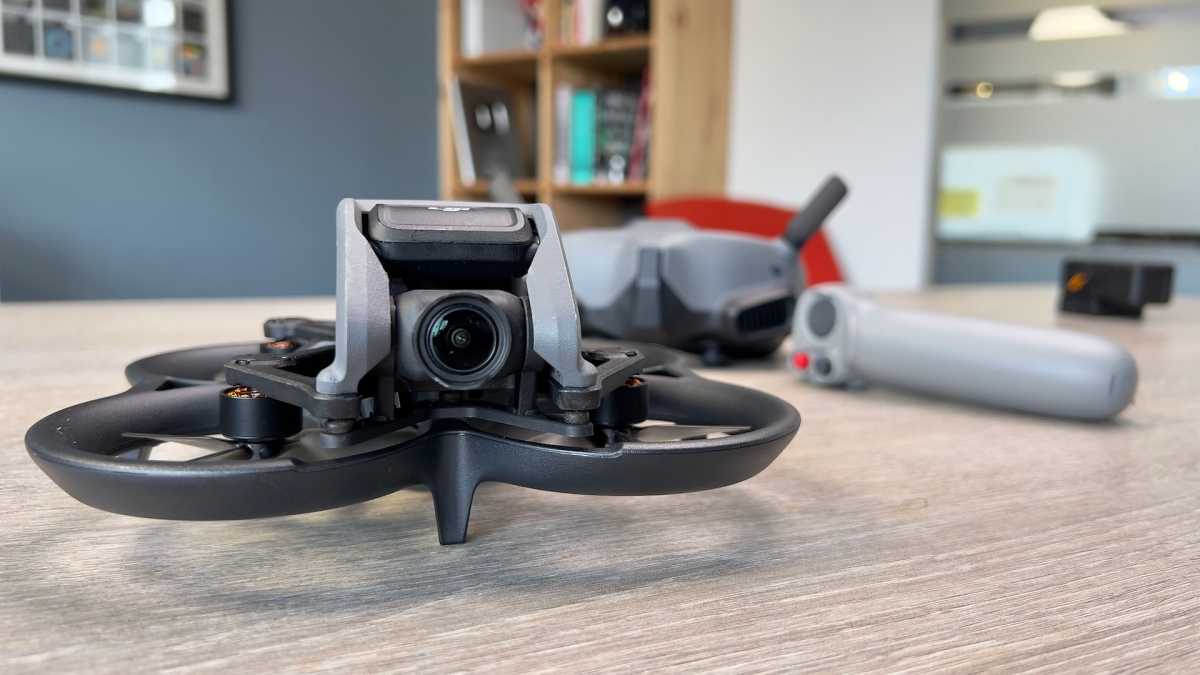
Lewis Painter / Foundry
Unlike a photo-focused drone with a gimbaled camera attached to its bottom, the DJI Avata’s camera is embedded within its body. This is a smart move from DJI with an FPV-focused drone where high-speed collisions are more common, keeping the camera tech out of harm’s way, but it also means you’ll sometimes catch a glimpse of the blade tips in videos – especially when braking.
One notable downgrade compared to the first-gen FPV drone is in the sensor department; while the Avata sports two downward-looking sensors to calculate the distance from the ground and generate ToF maps, it lacks the forward-facing sensors of the original FPV drone.
That means you won’t get real-time data on the distance of nearby objects via your headset like with the first-gen drone, though with a smaller, more durable build, it’s arguably less important this time around.
The only questionable design choice is the placement of the USB-C port and microSD card slot. While most alternatives offer body-mounted ports on the bottom for easy access, DJI decided to put the ports within one of the blade rings.
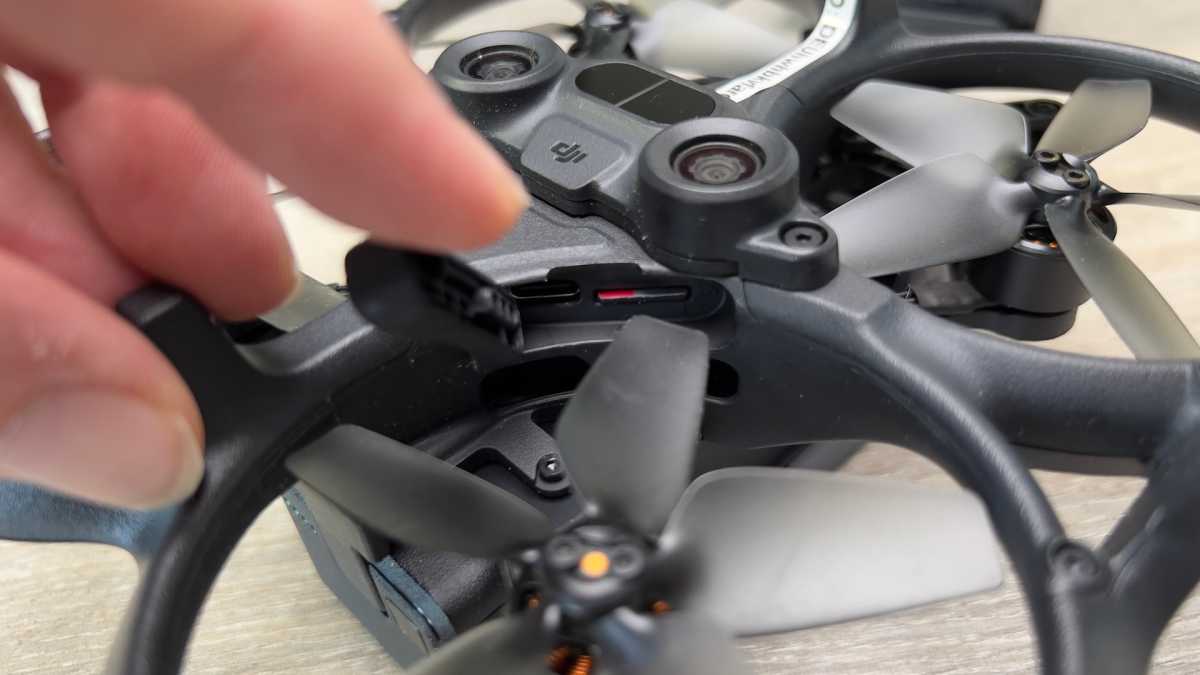
Lewis Painter / Foundry
It took quite a while for me to even locate the slots, hidden beneath a rubber seal, and it’s a very fiddly process to connect cables or a microSD card with a blade just millimetres away. It’s much easier to simply remove the blade entirely, but that’s not always ideal.
The main DJI Avata Pro View Combo bundles the DJI Avata with the DJI Motion Controller and the updated FPV-focused DJI Goggles 2.
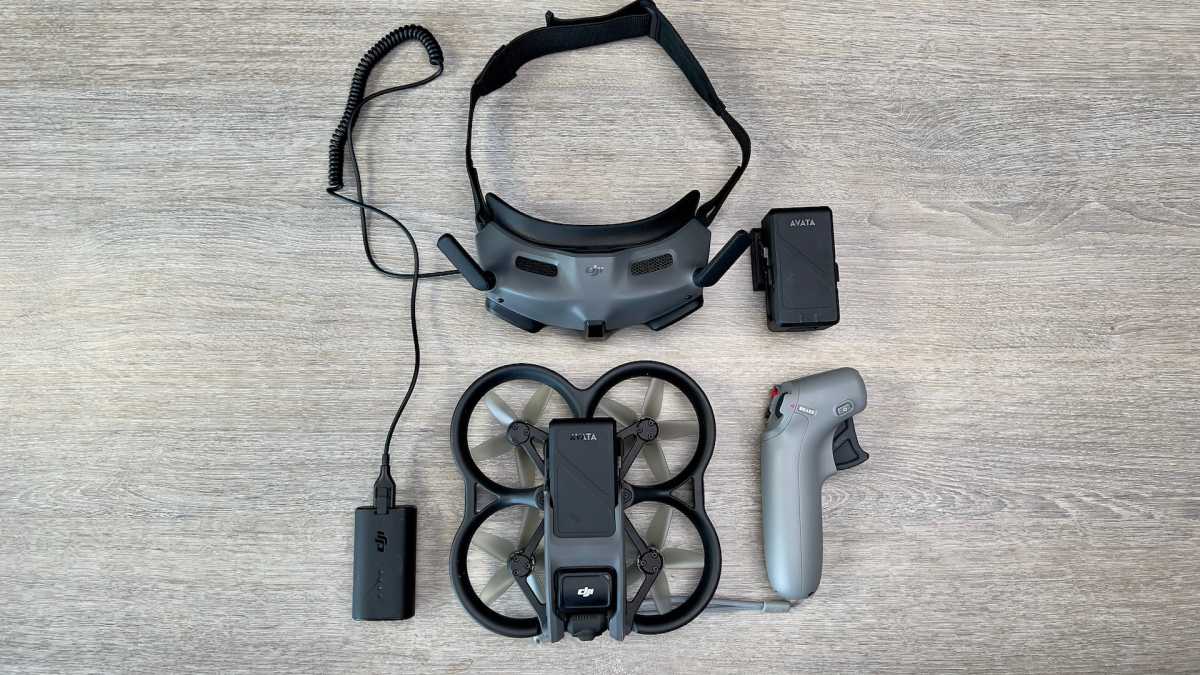
Lewis Painter / Foundry
Previously bundled with the DJI FPV, the DJI Motion Controller isn’t a new addition, but it provides an intuitive way for beginners to control the drone.
It acts in a similar way to a joystick, with motion measured by built-in sensors, and various controls – like a trigger accelerator, a large brake button, a RTH button and a recording button – provide most key functions you’d need during flight. It’s ultra-lightweight and comfortable to hold, with a USB-C port on the bottom for easy charging.

Lewis Painter / Foundry
DJI is clearly of the opinion that the Motion Controller is the ideal way to control fast-paced FPV drones, but it’s also compatible with the twin-stick FPV Remote Controller 2 if you want something more traditional.
The updated DJI Goggles 2 – not to be confused with the slightly older Goggles V2 – come in a much more slimline package than the original, and at a lightweight 500g, it’s comfortable to wear on the face over long periods. The headset ditches traditional controls for a touch panel, located on the right, and you’ll find dioptre controls on the bottom to adjust lens focus – perfect for glasses-wearers.
Unlike the controller, the Goggles 2 doesn’t feature a built-in battery, instead connecting to a small DJI-branded power pack via a coiled cable long enough to slip into your pocket without issue.
Features & flight
- Impressive video range of up to 10km
- Motion Controller is intuitive, ideal for beginners
- Top speed and certain functions are tied to twin-stick FPV Remote Controller 2
The key to FPV flight is the First Person View – the clue’s in the name – and that’s why upgrading the DJI Goggles was such a focus for DJI with the Avata. Compared to its predecessor, it’s not only lighter and more compact, but it boasts a swathe of tech upgrades that improve the FPV experience on offer.
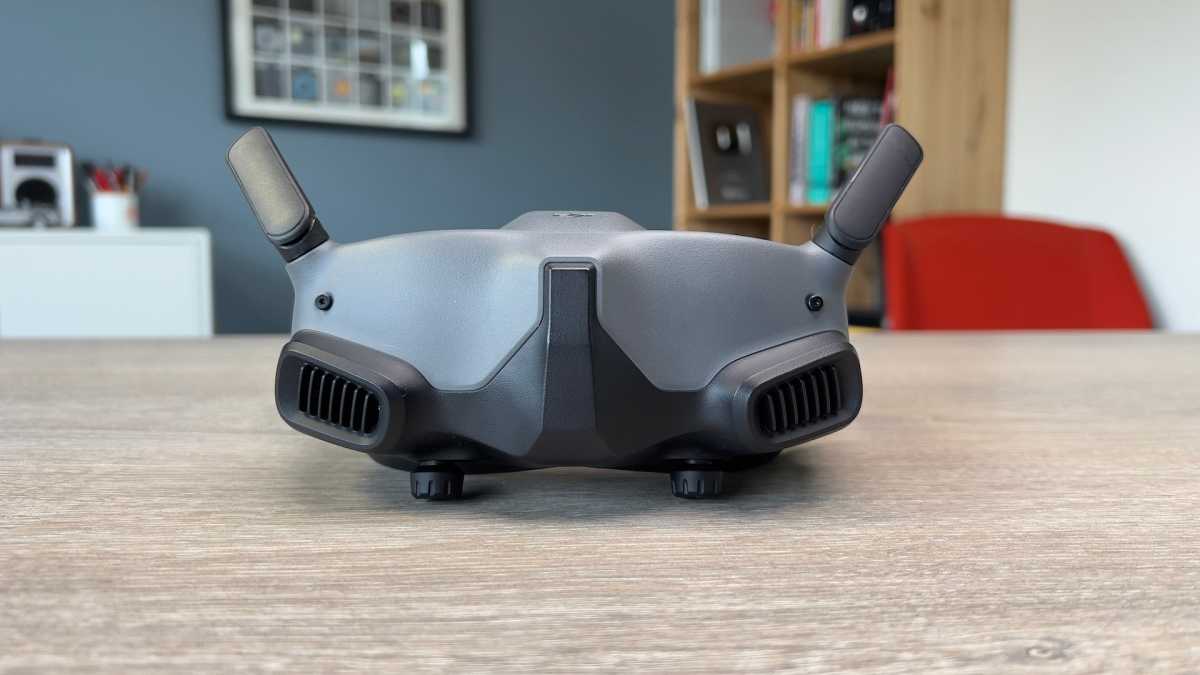
Lewis Painter / Foundry
One key new feature is upgraded micro-LED panels, which not only look more vibrant, but it’s higher resolution at 1080p with support for up to 100fps. The added detail helps keep you in the moment in FPV flight, picking out smaller obstacles – like a low-hanging branch – with ease.
Despite only using two antennae this time around, the DJI Goggles 2 sport the latest version of DJI’s transmission tech, Ocusync O3+. DJI claims that it’ll provide a video and control link of up to 10km – an impressive distance – though this is limited to 2km in Europe due to regulations. In my experience, the display has been able to provide crisp 1080p footage with just a 30ms response time up to a few hundred metres away in a built-up forest, and that’s improved when in open environments.
The DJI Goggles 2 sport a cut-down version of the DJI Fly app for iOS and Android built-in, meaning you don’t need to connect a smartphone or tablet to fly. You have the option of connecting a device via USB-C to update firmware, transfer video and provide a live camera feed for anyone else interested in your flight, but it’s not a requirement.
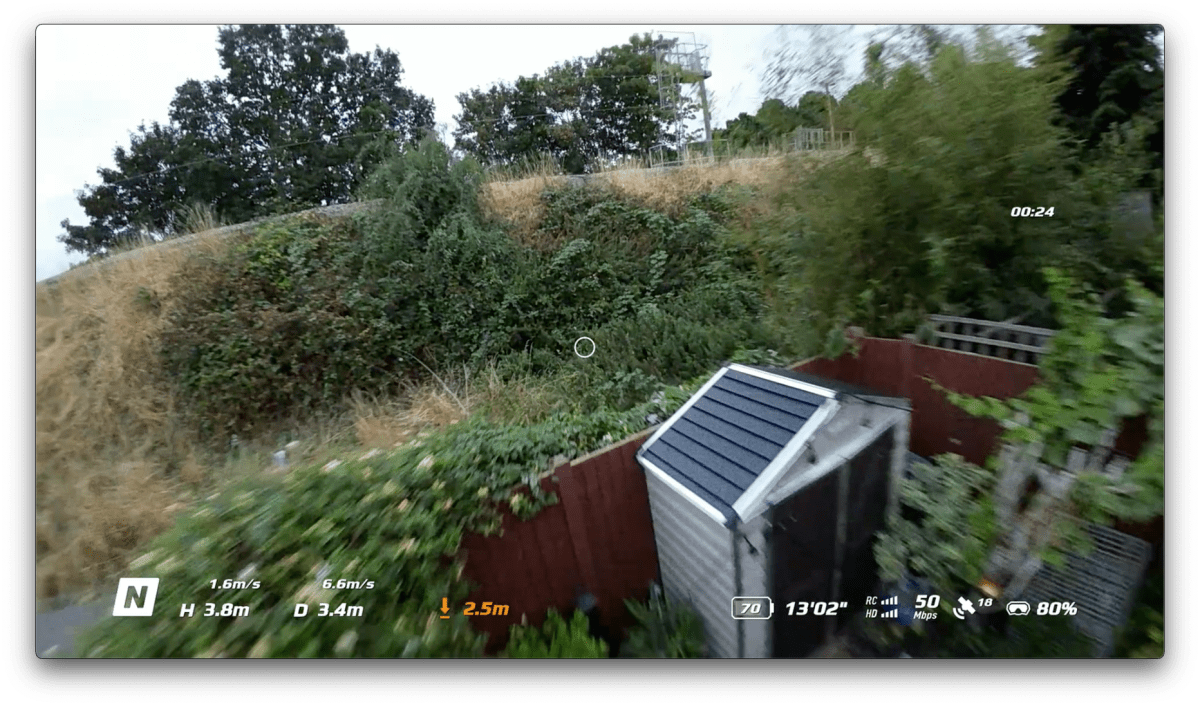
Lewis Painter / Foundry
The touch-sensitive panel on the right of the headset allows you to quickly change key settings like resolution and frame rate along with more advanced flight settings mid-flight without the need to take the headset off. It’s intuitive, once you get used to the various gestures for navigation.
The question is, how does the DJI Avata perform?
For a relative FPV newbie like myself, the DJI Avata is easily accessible, with the motion controller providing an exquisitely intuitive way to control the Avata during flight. While I’ve flown drones in the past, I’m not that confident when it comes to fast speeds and flying close to objects, but the Avata makes complex manoeuvres feel easy to execute with a control scheme like that of flight games on PC.
The learning curve is non-existent, taking no more than a few minutes to get used to the controls before I was whizzing through the air. It’s as easy to weave in and out of tree lines or fly through an open car window as it is to capture stunning vistas, making it perfect for those just getting into the thrill of FPV flight. The huge brake button also gives newbies like me added peace of mind.
Take a look at some of the 4K@60fps footage I captured below:
There are a few caveats when it comes to the DJI Motion controller though. The biggest is that it doesn’t give you complete control over all aspects of flight, with no way to ascend directly upwards or fly backwards, and that could be a problem in particularly cramped environments. It’s also speed limited to 14m/s (31mph) when using the motion controller.
To unlock the maximum speed of 27m/s (60mph), you’ll need to use DJI’s FPV Remote Controller 2 twin-stick controller. It provides even finer control of the drone in flight with access to all controls, though with a bigger learning curve than the motion controller – especially when it comes to more complex flights – it’s more aimed at pros than beginners.
Battery life is rated at 18 minutes when hovering, but expect less if you’re whizzing around at top speeds. In my experience, I found the drone’s 2420 mAh battery would last around 12-14 minutes per flight. You can buy additional batteries from DJI to extend flight time, but at $129/£109 a pop, it comes at a premium. The saving grace is that it only takes around an hour to fully charge the battery, minimising the time between flights.
Thankfully, the DJI Goggles 2 and Motion Controller last a little longer. The headset’s external battery can last around 110 minutes on a charge, good enough for multiple flights, while the motion controller can last up to five hours on a single charge, negating the need to charge the entire kit every time you fly.

Lewis Painter / Foundry
Camera performance
- Bigger sensor and higher megapixel count than predecessor
- Much-improved low-light performance
- Automated shooting modes aren’t available
Traditionally, FPV pilots have had to mount their own action cameras to their drones if they want to capture high-quality video for sharing on social media – and that can make them even more difficult to fly, especially at speed.
That’s not an issue with the DJI Avata, offering the ability to capture detailed, vibrant 4K video at 60fps as well as higher frame rates at 1440p and 1080p with its built-in camera.
Specifically, the DJI Avata sports a significant upgrade with a 1/1.7in CMOS sensor that boasts 64% more surface area to capture light than the 1/2.3in sensor of its predecessor. The biggest advantage is a boost in low-light conditions, but it also provides an improved dynamic range if you choose to shoot in D-Cinelike colour and colour grade with video editing software.
The camera’s automatic mode offers an ISO range of 100-6400 – great for most environments – but you can crank that up to an incredible 25600 for night-time recordings if you switch to the manual mode.

Lewis Painter / Foundry
As well as a larger sensor, the DJI Avata boasts an improved 48Mp resolution, 4x that of its predecessor. That may seem like overkill for a 4K output, but DJI uses the excess capture space to implement its RockSteady and HorizonSteady tech.
RockSteady tech was available on the DJI FPV, helping stabilise footage in general flight for a smother experience using electronic image stablisation, while HorizonSteady is a new addition to DJI’s FPV-focused range, helping keep the horizon straight even when banking of the drone. Combined, the DJI Avata is capable of recording impressively smooth video at fast speeds, even when banking left and right, and that elevates the overall look of videos captured.
There’s also 20GB of built-in storage, so forgetting to pack a microSD before a flight isn’t as much of an issue as it would be with most alternatives. It’s able to capture around 15-20 minutes of 4K@60fps footage, though that’s expandable by up to 256GB via the awkwardly placed microSD card slot mentioned earlier.
But, for all the strong points about the Avata’s camera setup, this isn’t a drone focused on aerial photography and as such, there are limitations to its offering. That means you don’t get the same automated flight modes as other DJI drones, missing QuickShot features like Dronie and Helix that capture cool shots without any input from the pilot, and due to the single-axis movement of the camera, you can only look up and down without rotating the drone.
It’s still capable of capturing amazing FPV footage, but if you want a drone that prioritises a top-notch photo and video experience, consider the DJI Mini 3 Pro.
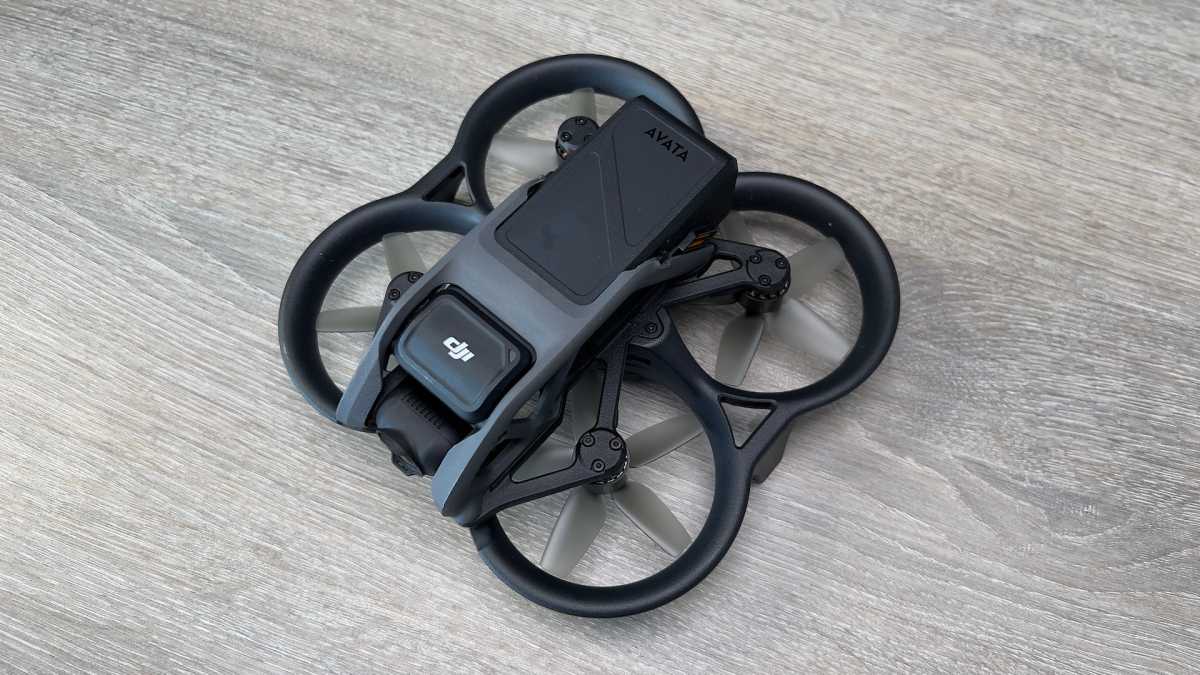
Lewis Painter / Foundry
Price
The DJI Avata is an incredibly fun FPV drone, but there’s no denying that it’s expensive – especially for those new to FPV flight.
The DJI Avata comes in at a cool $579/£499, and while that doesn’t seem too bad, that’s designed for first-gen DJI FPV owners that already have a headset and controller to hand.
Those new to the world of DJI-branded FPV flight will have to opt for the DJI Avata Pro View combo, which will set you back a much more significant $1,429/£1,299. DJI argues that you’ll probably spend close to that building a similarly specced FPV drone yourself from third-party parts, but it doesn’t make the price any easier to swallow.
If you are tempted, the DJI Avata is available to purchase from the DJI website along with key retailers like B&H Photo Video in the US and Jessops in the UK. To see how it compares to the competition, take a look at our selection of the best drones.
Verdict
If you’re new to the world of FPV drones, the DJI Avata provides the ideal entry point – as long as you can stomach the premium price tag that comes along with it.
The DJI Avata is an all-around improvement on the first-gen DJI FPV, with a smaller, more durable chassis, an improved camera setup with a particular focus on low-light performance and more. The bundled DJI Goggles 2 also offer a leap forward, with micro-LED displays and a maximum video range of an impressive 10km in regions where it’s permitted.
That experience is truly elevated with DJI’s Motion controller. While not new, the joystick-shaped controller provides an impressively intuitive way for new FPV pilots to whizz through the air and capture shots near-impossible with a twin-stick controller without a lot of practice. There is a trade-off in terms of top speed and functionality, but the pros can get around this by opting for DJI’s twin-stick FPV Remote Controller 2.
Specs
- 180 x 180 x 80mm
- 410g
- Max speed 14 m/s (or 27 m/s with the FPV Controller 2)
- Dual antennas
- 7ms response time
- 20GB storage, expandable by 256GB
- 2420mAh removable battery
- 10km max video transmission range
- 1/1.7in CMOS sensor, 48Mp camera f/2.8
- Up to 4K@60fps
- Single-axis tilt
- Compatible with DJI Motion Controller
- Compatible with DJI Goggles 2
- Compatible with DJI FPV Controller 2




